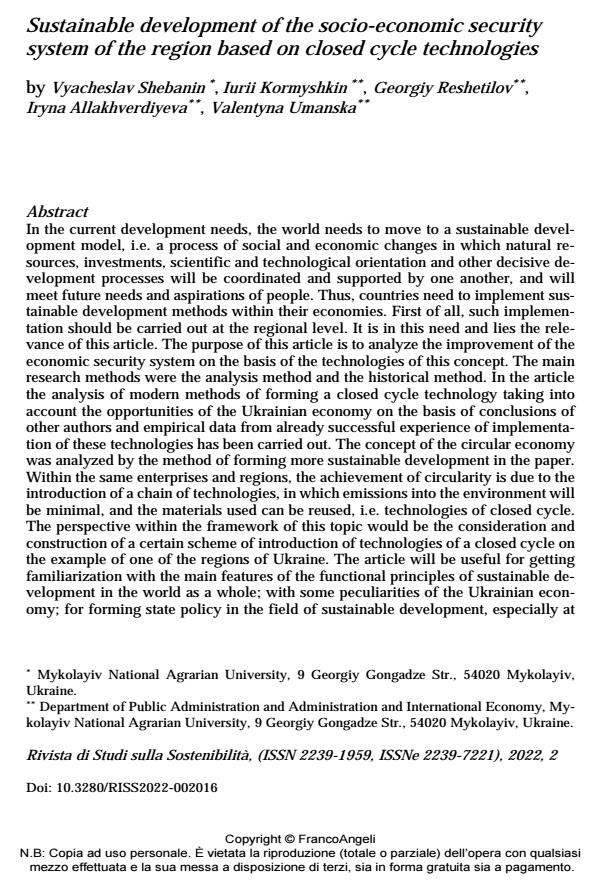Sustainable development of the socio-economic security system of the region based on closed cycle technologies
Titolo Rivista RIVISTA DI STUDI SULLA SOSTENIBILITA'
Autori/Curatori Vyacheslav Shebanin, Iurii Kormyshkin, Georgiy Reshetilov, Iryna Allakhverdiyeva, Valentyna Umanska
Anno di pubblicazione 2023 Fascicolo 2022/2
Lingua Inglese Numero pagine 18 P. 271-288 Dimensione file 214 KB
DOI 10.3280/RISS2022-002016
Il DOI è il codice a barre della proprietà intellettuale: per saperne di più
clicca qui
Qui sotto puoi vedere in anteprima la prima pagina di questo articolo.
Se questo articolo ti interessa, lo puoi acquistare (e scaricare in formato pdf) seguendo le facili indicazioni per acquistare il download credit. Acquista Download Credits per scaricare questo Articolo in formato PDF

FrancoAngeli è membro della Publishers International Linking Association, Inc (PILA)associazione indipendente e non profit per facilitare (attraverso i servizi tecnologici implementati da CrossRef.org) l’accesso degli studiosi ai contenuti digitali nelle pubblicazioni professionali e scientifiche
In the current development needs, the world needs to move to a sustainable devel-opment model, i.e. a process of social and economic changes in which natural resources, investments, scientific and technological orientation and other decisive development processes will be coordinated and supported by one another, and will meet future needs and aspirations of people. Thus, countries need to implement sustainable development methods within their economies. First of all, such imple-mentation should be carried out at the regional level. It is in this need and lies the relevance of this article. The purpose of this article is to analyze the improvement of the economic security system on the basis of the technologies of this concept. The main research methods were the analysis method and the historical method. In the article the analysis of modern methods of forming a closed cycle technolo-gy taking into account the opportunities of the Ukrainian economy on the basis of conclusions of other authors and empirical data from already successful experi-ence of implementation of these technologies has been carried out. The concept of the circular economy was analyzed by the method of forming more sustainable development in the paper. Within the same enterprises and regions, the achieve-ment of circularity is due to the introduction of a chain of technologies, in which emissions into the environment will be minimal, and the materials used can be re-used, i.e. technologies of closed cycle. The perspective within the framework of this topic would be the consideration and construction of a certain scheme of introduc-tion of technologies of a closed cycle on the example of one of the regions of Ukraine. The article will be useful for getting familiarization with the main features of the functional principles of sustainable development in the world as a whole; with some peculiarities of the Ukrainian economy; for forming state policy in the field of sustainable development, especially at the regional level; for studying some subjects by students, as well as other authors in writing their works.
Parole chiave:closed-loop economy, model Pakhomova and Rikhter, regional devel-opment, Ukrainian economy, macroeconomics.
- Agricultural sector circular economy development: Agroecological approach Olena Dovgal, Natalia Potryvaieva, Oleksandr Bilichenko, Vitalii Kuzoma, Tetiana Borko, in Ekonomika APK /2024 pp.10
DOI: 10.32317/ekon.apk/4.2024.10 - Circular economy of the agricultural sector: Strategies and challenges in the context of globalisation Vyacheslav Shebanin, Olena Shebanina, Iurii Kormyshkin, Antonina Drobitko, Natalia Potryvaieva, in Scientific Horizons /2024 pp.148
DOI: 10.48077/scihor9.2024.148
Vyacheslav Shebanin, Iurii Kormyshkin, Georgiy Reshetilov, Iryna Allakhverdiyeva, Valentyna Umanska, Sustainable development of the socio-economic security system of the region based on closed cycle technologies in "RIVISTA DI STUDI SULLA SOSTENIBILITA'" 2/2022, pp 271-288, DOI: 10.3280/RISS2022-002016